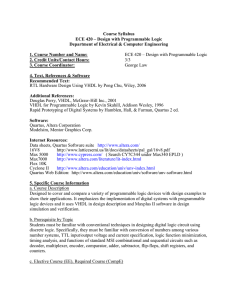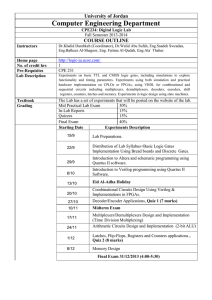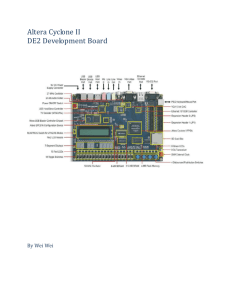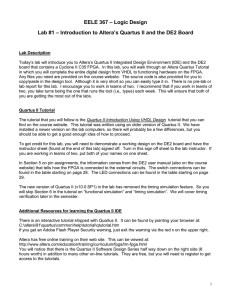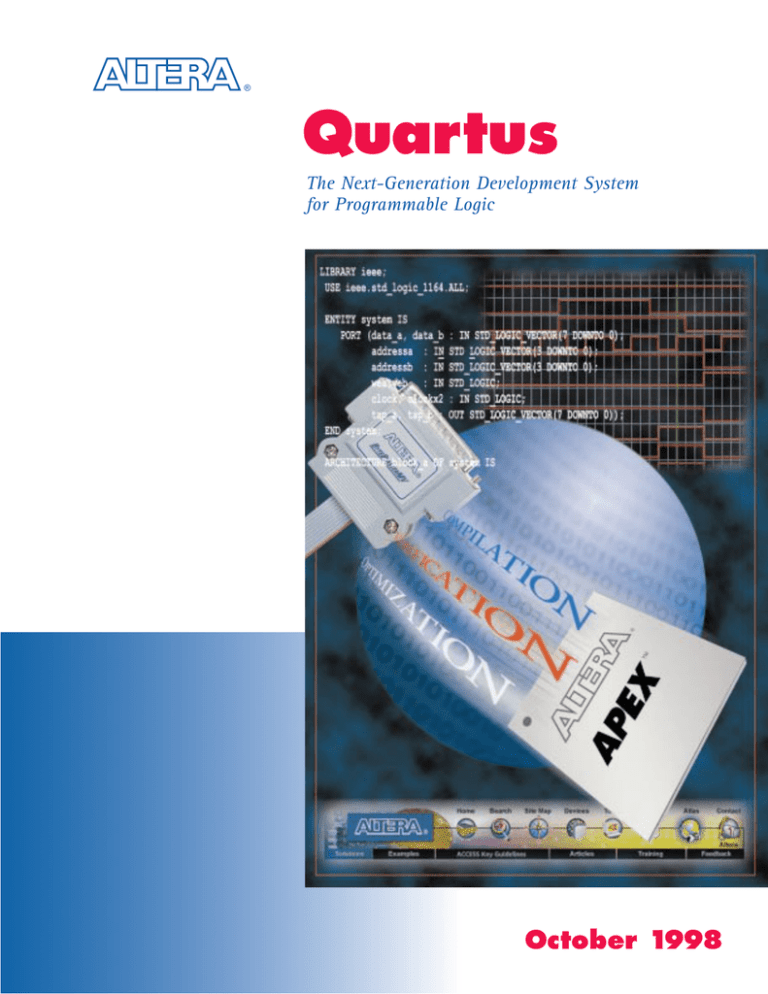
®
Quartus
The Next-Generation Development System
for Programmable Logic
October 1998
Design Tools for Increasing
Device Densities
As device densities increase, design methodologies
for programmable logic devices (PLDs) must continue
to evolve. The Quartus™ software, Altera's fourthgeneration development system for programmable
logic, allows designers to process multi-million gate
designs with advancements never before seen in PLD
development tools. With the Quartus software, Altera
continues its commitment to provide development
software with unmatched flexibility and performance.
Figure 1. Quartus Software Supports High-Density
Design Methodology
10,000,000
APEX 20K
Gates
FLEX 8000
MAX 5000
CLASSIC
A+PLUS
1,000
MAX+PLUS
MAX 7000
10,000
MAX+PLUS II
FLEX 10K
100,000
QUARTUS
1,000,000
tools, allowing designers to use the tools they are
already familiar with to design for Altera® devices.
As the industry's first “Internet-aware" development
tool, the Quartus software provides up-to-the-minute
information and file exchanges, including software
updates, license file delivery, and support services
across the Internet. Altera effectively becomes a
member of the design team by providing an
unmatched level of technical support. Together, these
features make Quartus software the ideal platform for
multi-million gate designs.
Shortened Compilation Times with the
nSTEP Compiler
Complex designs often require several design
iterations to achieve desired results. Before Quartus
software, designers needed to perform a full compilation with each iteration before they could examine
results. Now, the Quartus nSTEP™ Compiler allows
designers to make changes and obtain results without running a full compilation. The Quartus software
only compiles the portions of the design that have
changed. This powerful feature significantly shortens
compile times and maintains placement and timing
in portions of the design that are unchanged.
CoreSyn Synthesis
100
1984 1986 1988 1990 1992 1994 1996 1998 2000 2002 2004
The Quartus software offers new process advances
that use state-of-the-art features—such as multiprocessor support and incremental recompiling—to
shorten design cycles. To streamline the development
flow and increase productivity, the Quartus software
supports system-on-a-chip methodology with blocklevel editing, workgroup computing, and expanded
support for megafunctions. A new logic analysis
solution reduces verification time by enabling engineers to see internal chip signal values while the
system is running at speed. Quartus software also
interfaces seamlessly with third-party EDA software
The nSTEP Compiler uses Altera's new CoreSyn™
synthesis capability. The Compiler analyzes the
design and then partitions functions into the appropriate type of look-up table (LUT)-based logic element, product-term-based macrocell, or embedded
memory logic block within the APEX™ architecture.
Using the CoreSyn capability, the nSTEP Compiler
then invokes the appropriate synthesis technology to
optimize the logic for that architecture.
Utilizing the Full Computing Power
With the power of PCs and workstations increasing
at incredible rates, design tools must be equipped to
take advantage of these benefits. The Quartus software was designed from the ground up to fully
utilize these improvements by distributing computerintensive functions to multiple processors. The
Quartus software uses the processing power of multiple processors—locally or across a network—and even
across multiple operating systems. This feature saves
considerable time during the compilation process.
Altera Corporation
Collaborative Work Environment
As designs get larger, several engineers may work on
a single project. The Quartus software uses a centralized object-oriented database that can be accessed by
multiple engineers across a network. Commercially
available revision control systems or user-integrated
systems within the Quartus software preserve the
integrity of design revisions as multiple engineers
make changes to the design. This feature allows
engineers to work on the same project from different
sites without interrupting the design cycle.
Program (AMPPSM). AMPP
provides a broad portfolio
of Altera-optimized megafunctions that are developed by third-party vendors.
Quartus software will expand the support for
megafunctions by enabling instance-specific assignments and greater control over synthesis. Customers
can maintain assignments for each instance of a
MegaCore or AMPP megafunction in a design rather
than for each function.
Risk-Free Evaluation with OpenCore
Megafunctions for High-Density Design
Creating designs for system-on-a-chip architectures
requires efficiency throughout the design cycle.
Designers can use functions that
have already been tested and optimized to further reduce their design
time. Altera users have two primary MegaCore
choices of functions: Altera-created
megafunctions—called MegaCore™ functions—that are
optimized for Altera device architectures, and megafunctions from the Altera Megafunction Partners
TM
The Quartus OpenCore™ evaluation feature offers you
a risk-free method of evaluating AMPP and
MegaCore functions. With the
OpenCore feature, you can instantiate, compile, and simulate your
designs to verify a function's size
OpenCore
and performance before making a
licensing decision. MegaCore functions can be downloaded for OpenCore evaluation from the Altera
world-wide web site at http://www.altera.com.
Altera Corporation
TM
Improved Verification Flow and
SignalTap Logic Analysis
Design verification has become the longest process
in developing multi-million gate designs. The
Quartus software reduces verification time by
providing tight integration to register transfer level
(RTL)-based simulation. The Quartus Simulator can
accept TCL, C, and hardware description language
(HDL) test-benches.
The Quartus software also easily integrates with
third-party simulators, allowing you to choose the
most efficient verification flow to fit your needs. In
addition to running software simulations, designers
can use Altera’s SignalTap™ logic analysis to perform
hardware debugging.
For many designs, system-level verification is very
time-consuming, and sometimes extremely difficult
on devices with high I/O ball-grid array packages.
SignalTap logic analysis facilitates the verification
process by integrating the functionality of a logic
analyzer within the software.
numerous operating conditions. Also, a PLD implementation enables development to begin earlier on
real hardware, rather than on software models or
emulators.
Elimination of the Probing Bottleneck
For PLDs with embedded RAM, a logic analyzer can
be implemented in silicon, eliminating the need for an
external analyzer. Because it is on-chip, the logic analyzer has full access to any signal in the design. Data
is stored in the embedded RAM, and scanned out serially to preserve I/O pins. This data is then assembled
on a PC and presented in a waveform display.
Flexibility of PLDs
Changes in the design and in the configuration of
the logic analyzer can be made quickly and painlessly with PLDs.
Figure 2. Quartus Verification Interface
Designers can capture internal signals of a device
and route them to pins for monitoring using
SignalTap logic analysis. The Quartus software
inserts a logic analyzer megafunction that incorporates the functionality of a logic analyzer and the
triggering options into the design. Data is stored in
the device's embedded RAM block and reported to
the Quartus waveform viewer via a download cable.
The SignalTap logic analysis tool allows the design
team to perform this analysis on a device running at
actual speed.
SignalTap logic analysis accelerates the verification
flow by building upon the fact that programmable
logic offers the benefit of shortening design cycles. For
verification purposes, PLDs offer specific advantages:
True System-Level Verification
Because PLDs remove the risks associated with
silicon changes, multiple verification iterations can
be made on PLDs. These iterations can be performed
in-system at system clock speeds. Millions of true
system vectors can be applied per second to test
Designers can continue using their verification tools
and flows with the Quartus software, and avoid the
steep learning curve that is typically involved with
using a new software tool. They can also take
advantage of the innovative SignalTap logic analysis
solution to perform system-level verification on
chips running at speed. Designs can go into production much faster with these enhancements to the
verification process.
Altera Corporation
NativeLink Integration with
Major Design Tools
Error-Location Capability
Digital system design flows typically require the
use of several different EDA tools to perform tasks
from design entry and synthesis to verification and
programming. These tools require efficient transfer of
information. NativeLink™ integration facilitates the
seamless transfer of information between the Quartus
software and other EDA tools to enhance the overall
productivity of the designer's EDA tool suite.
Altera has worked very closely with major EDA vendors to develop the best interface any PLD software
has to offer. Altera opened the Quartus interface to
various EDA partners to enable them to provide
unmatched levels of integration. NativeLink integration provides a truly seamless interface to major EDA
software tools to support existing design flows, eliminating the need to learn new design tools.
Improved Quality of Results
Quartus software provides improved quality of
results as well as a variety of features not available
in any other tool today. The NativeLink flow allows
designers to use Quartus pre-place and route estimates in third-party EDA tools to optimize synthesis
strategies. Incremental design changes do not require
a total recompilation of the design, further streamlining the design process.
Figure 3. NativeLink Example
While most interfaces allow design information to be
passed from one tool to another, they provide little
or no interaction between tools. Using the Quartus
software, error location and correction is easier
than ever before. The Quartus software can identify
the source of errors in the EDA tool's source design
file, and the errors can be corrected directly in the
EDA tool.
Internet-Based Support
The Quartus software is engineered with the latest
Internet browser. Designers with Internet access can
use Quartus software to connect directly to Altera's
web site—including the AtlasSM Solutions database—
from within the software. This direct access
provides users with immediate solutions, hints, and
workarounds to issues they may face during the
design cycle.
Customers can also submit service requests directly
to Altera Applications and monitor their progress via
the internet while in the Quartus software. The
design files and user configuration details can automatically be prepared for transfer to Altera. This
feature ensures that the Altera Applications engineer
working on the issue can accurately duplicate the
design environment. With this feature, Altera effectively becomes an active member of the design team.
Automatic notifications of software patches, new
device support, and online help updates are communicated on a daily basis by the Quartus software.
Users are prompted to download the latest software
upgrades. Designers can choose to have the Quartus
software update their design site to ensure access to
the latest information.
Altera Corporation
APEX 20K: A Revolutionary
Embedded Architecture
APEX™ 20K, Altera's new high-performance, highdensity, embedded PLD family that is designed for
system-level integration, integrates look-up-table
logic, product-term logic, and memory in a single
device with densities up to 2 million gates. This
revolutionary architecture, called the MultiCore™
architecture, is fabricated on an advanced 0.25-micron
SRAM process, and combines and enhances the
strengths of the FLEX® 10K, FLEX 6000, and
MAX® 7000 architectures to provide an efficient, highperformance solution for system-level applications.
APEX 20K devices are made up of MegaLAB™ blocks
which contain 16 logic array blocks (LABs), an
advanced embedded structure called an embedded
system block (ESB), and a local interconnect that
connects all 16 LABs and the ESB without requiring
global routing resources. The ESB can be configured
as product-term logic, LUT logic, RAM, ROM or content addressable memory (CAM). APEX 20K devices
also offer enhanced ClockLock™ and ClockBoost™
circuitry, and support multiple I/O interfacing standards, including LVTTL, LVCMOS, LVDS, GTL/GTL+,
and SSTL-3.
The Convenience of Subscription
Customers can purchase development tool subscriptions from Altera for 12-month periods. This annual
subscription entitles the customer to the initial
installation of the software, as well as all Altera
development system updates and releases over the
subsequent 12-month period. Customers will receive
the latest versions of the Quartus and MAX+PLUS® II
software, providing support for all Altera PLDs, new
software features, performance enhancements, and
the most current online and printed documentation.
With a subscription, designers will gain access to the
most cost-effective, fastest, and highest density PLDs
in the industry. As new device families, packages,
and speed grades become available, customers will
automatically receive support for these newest Altera
devices.
For more information, please contact your local
Altera sales office.
Altera Offices
Altera Corporation
101 Innovation Drive
San Jose, CA 95134
Telephone: (408) 544-7000
http://www.altera.com
Altera U.K., Ltd.
Holmers Farm Way
High Wycombe
Buckinghamshire
HP12 4XF
United Kingdom
Telephone: (44) 1 494 602 000
Altera Japan, Ltd.
Shinjuku Mitsui Bldg. 36F
1-1, Nishi-Shinjuku, 2 Chome
Shinjuku-ku, Tokyo 163-0436
Japan
Telephone: (81) 3 3340 9480
http://www.altera.com/japan
Altera International, Ltd.
Suites 908-920, Tower 1
MetroPlaza
223 Hing Fong Road
Kwai Fong, New Territories
Hong Kong
Telephone: (852) 2487 2030
Copyright © 1998 Altera Corporation. Altera, AMPP, APEX, APEX 20K, ATLAS, ByteBlaster, ClockLock, ClockBoost, CoreSyn, FLEX, FLEX 10K, FLEX 10KA, FLEX 10KE, FLEX 8000,
FLEX 6000, MAX, MAX 9000, MAX 7000, MAX 7000A, MAX 7000E, MAX 7000S, MAX 5000, A+PLUS, MAX+PLUS, MAX+PLUS II, MegaCore, MegaLAB, MultiCore, NativeLink,
nSTEP, OpenCore, Quartus, SignalTap, and specific device designations are trademarks and/or service marks of Altera Corporation in the United States and other countries. Other brands
or products are trademarks of their respective holders. The specifications contained herein are subject to change without notice. All rights reserved.
M-GB-QUARTUS-01




